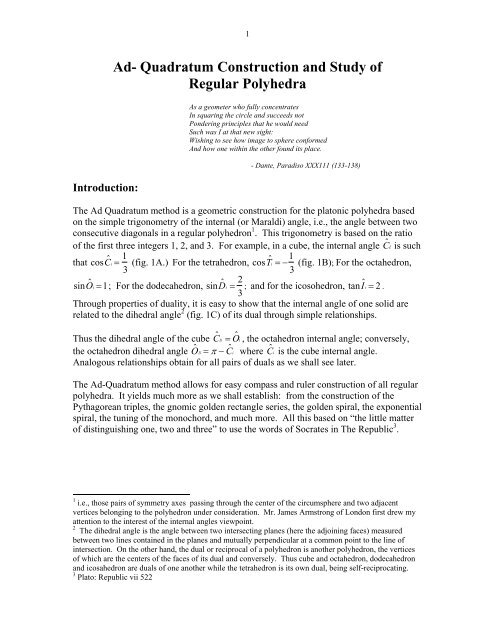Ad Quadratum Construction and Study of the Regular Polyhedra
Ad Quadratum Construction and Study of the Regular Polyhedra
Ad Quadratum Construction and Study of the Regular Polyhedra
Create successful ePaper yourself
Turn your PDF publications into a flip-book with our unique Google optimized e-Paper software.
Introduction:<br />
1<br />
<strong>Ad</strong>- <strong>Quadratum</strong> <strong>Construction</strong> <strong>and</strong> <strong>Study</strong> <strong>of</strong><br />
<strong>Regular</strong> <strong>Polyhedra</strong><br />
As a geometer who fully concentrates<br />
In squaring <strong>the</strong> circle <strong>and</strong> succeeds not<br />
Pondering principles that he would need<br />
Such was I at that new sight:<br />
Wishing to see how image to sphere conformed<br />
And how one within <strong>the</strong> o<strong>the</strong>r found its place.<br />
- Dante, Paradiso XXX111 (133-138)<br />
The <strong>Ad</strong> <strong>Quadratum</strong> method is a geometric construction for <strong>the</strong> platonic polyhedra based<br />
on <strong>the</strong> simple trigonometry <strong>of</strong> <strong>the</strong> internal (or Maraldi) angle, i.e., <strong>the</strong> angle between two<br />
consecutive diagonals in a regular polyhedron 1 . This trigonometry is based on <strong>the</strong> ratio<br />
<strong>of</strong> <strong>the</strong> first three integers 1, 2, <strong>and</strong> 3. For example, in a cube, <strong>the</strong> internal angle C ˆ i is such<br />
that cosC<br />
ˆ i 1<br />
(fig. 1A.) For <strong>the</strong> tetrahedron, cosT ˆ i <br />
3 1<br />
(fig. 1B); For <strong>the</strong> octahedron,<br />
3<br />
sin ; For <strong>the</strong> dodecahedron, sin<br />
ˆ O i 1<br />
D ˆ 2<br />
i ; <strong>and</strong> for <strong>the</strong> icosohedron, tanI ˆ i 2 .<br />
3<br />
Through properties <strong>of</strong> duality, it is easy to show that <strong>the</strong> internal angle <strong>of</strong> one solid are<br />
related to <strong>the</strong> dihedral angle 2 (fig. 1C) <strong>of</strong> its dual through simple relationships.<br />
Thus <strong>the</strong> dihedral angle <strong>of</strong> <strong>the</strong> cube C ˆ D O ˆ i , <strong>the</strong> octahedron internal angle; conversely,<br />
<strong>the</strong> octahedron dihedral angle O ˆ D C ˆ i where C ˆ i is <strong>the</strong> cube internal angle.<br />
Analogous relationships obtain for all pairs <strong>of</strong> duals as we shall see later.<br />
The <strong>Ad</strong>-<strong>Quadratum</strong> method allows for easy compass <strong>and</strong> ruler construction <strong>of</strong> all regular<br />
polyhedra. It yields much more as we shall establish: from <strong>the</strong> construction <strong>of</strong> <strong>the</strong><br />
Pythagorean triples, <strong>the</strong> gnomic golden rectangle series, <strong>the</strong> golden spiral, <strong>the</strong> exponential<br />
spiral, <strong>the</strong> tuning <strong>of</strong> <strong>the</strong> monochord, <strong>and</strong> much more. All this based on “<strong>the</strong> little matter<br />
<strong>of</strong> distinguishing one, two <strong>and</strong> three” to use <strong>the</strong> words <strong>of</strong> Socrates in The Republic 3 .<br />
1 i.e., those pairs <strong>of</strong> symmetry axes passing through <strong>the</strong> center <strong>of</strong> <strong>the</strong> circumsphere <strong>and</strong> two adjacent<br />
vertices belonging to <strong>the</strong> polyhedron under consideration. Mr. James Armstrong <strong>of</strong> London first drew my<br />
attention to <strong>the</strong> interest <strong>of</strong> <strong>the</strong> internal angles viewpoint.<br />
2 The dihedral angle is <strong>the</strong> angle between two intersecting planes (here <strong>the</strong> adjoining faces) measured<br />
between two lines contained in <strong>the</strong> planes <strong>and</strong> mutually perpendicular at a common point to <strong>the</strong> line <strong>of</strong><br />
intersection. On <strong>the</strong> o<strong>the</strong>r h<strong>and</strong>, <strong>the</strong> dual or reciprocal <strong>of</strong> a polyhedron is ano<strong>the</strong>r polyhedron, <strong>the</strong> vertices<br />
<strong>of</strong> which are <strong>the</strong> centers <strong>of</strong> <strong>the</strong> faces <strong>of</strong> its dual <strong>and</strong> conversely. Thus cube <strong>and</strong> octahedron, dodecahedron<br />
<strong>and</strong> icosahedron are duals <strong>of</strong> one ano<strong>the</strong>r while <strong>the</strong> tetrahedron is its own dual, being self-reciprocating.<br />
3 Plato: Republic vii 522




